The middle school team at Rutland Town School in Rutland, VT have been working on a more fully integrated implementation of personal learning plans (PLPs) at their school.
They’re also passionate believers in student choice and learner-centered classrooms. Given some flexibility to change the school schedule, they came up with iLearn, a model of student self-direction and choice in tackling PLPs.

Members of the Rutland Town School middle school team — including Brian Crane, Erica Zimmer and Melissa Theis — presented their scheduling and school choice project, “iLearn” at the 2017 Middle Grades Conference. A transcript of the presentation appears below.
Brian Crane: We ask the question:
“How do we improve self-direction and PLPs in our school?”
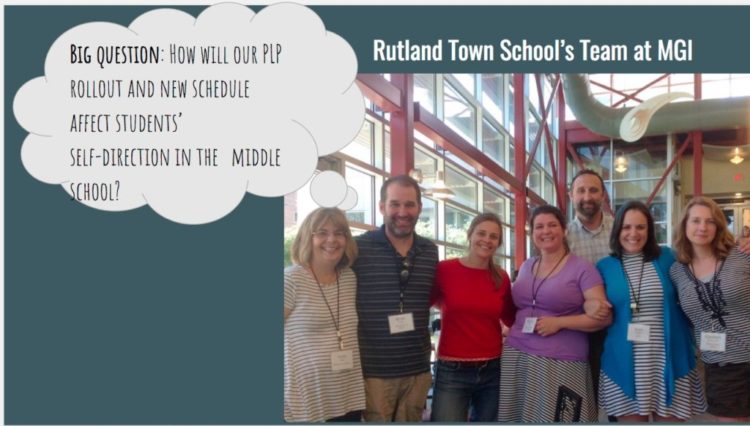
Like any good idea, this was born from a problem.
Melissa Theis: Last year, we were trying to accomplish PLPs and I was the only one teaching all of our 115 students and trying to fit it in a 30-minute block, which was our flex time. Yes, we did PLPs, but it was not connected in any way to our teachers in the middle school. They had no idea what was happening with students, and it wasn’t connected to our group at all.
So, we wanted to think of a creative solution to make those things happen: how to change our schedule to be able to do that.
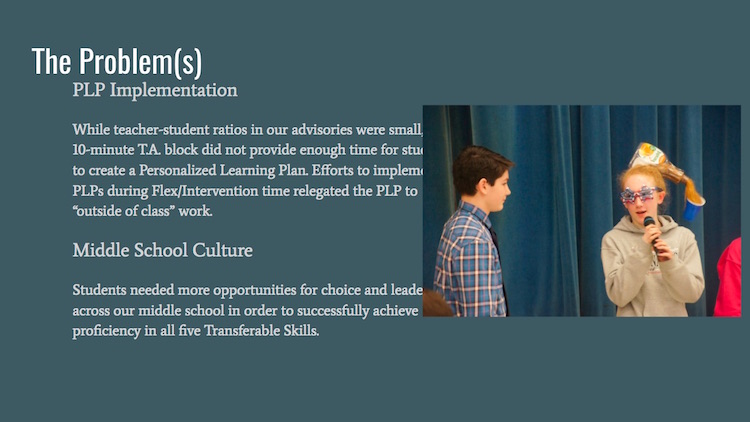
Erica Zimmer: This year where we have what we call an “iLearn” block in the morning. Tuesday through Friday.
Before in the schedule, there would be electives and flex or response intervention time. But we noticed that a lot of kids that had to go to these response interventions missed out on a lot of the fun electives. And we wanted them to participate as well.
So we came up with this extended teacher’s advisory (TA). It’s done in two-week blocks, and on the first Monday of the block, students sign up for classes. They have a variety of options, and some of them are exploratory.
Teachers might have something that a student mentioned they want to explore, so that gets offered, and shared with other students. There’s also office hour times. Teachers may be like: “You know what, I have some kids struggling with something so, I’m going to offer some office hour times this weekend next week.”
On the first Monday, students meet individually with their TA teacher — we wanted to preserve that relationship between the adviser and the student — to choose what they will do during iLearn, Tuesday through Friday for the two weeks.
The adviser can say, “Hey, it looks like you’re struggling a little bit in this class. Maybe you need to have office hours with that teacher”, or “I know you don’t have internet at home. Can we pick out some office hours during the week where you could just use your prompt up to get things done that you need to accomplish?” Or, “I know you’re really into art. Let’s find some things that might relate in the exploratory because that’s what really interests you.”
Brian Crane: The bottom line is Mondays are PLP work; then Tuesday through Friday, the students are making the choice of where they go, which is really mind-boggling, allowing every student to make their own choices.
So, how can we use this new block of time that our administrators so generously gave us to build community and maximize student choice?
One thing to know about our district is our district, we are moving towards proficiency-based grading and learner-centered classrooms. In learner-centered classrooms, teachers no longer give direct instruction. I never get up in front of the room and explain, “Hey, density is equal to mass over volume.” If I’m no longer giving instruction, the kids are in-charge of their own learning.

In my experience, they’re making excellent choices. I’ve had to let go of a lot of things this year. It’s been a hard but really, really profound year. I had to let go and let students make their choices: bad choices and good choices.
But without self-direction skills, it all falls apart. They can’t drive their own learning if they don’t know how.
That’s where this iLearn comes in.
[huge_it_slider id=”14″]
Brian Crane: One of the big problems we had is that we have around 115 students all signing up for iLearn classes essentially every other Monday. When you have 115 entries going in to the same spreadsheet, how do you get everybody to sign up at the same time?
What will happen is, for example, the Friday before the start of the iLearn block, students will get a listing of what office hours are available, when teachers want to work on content, and what exploratories are available, what special things teachers are offering.
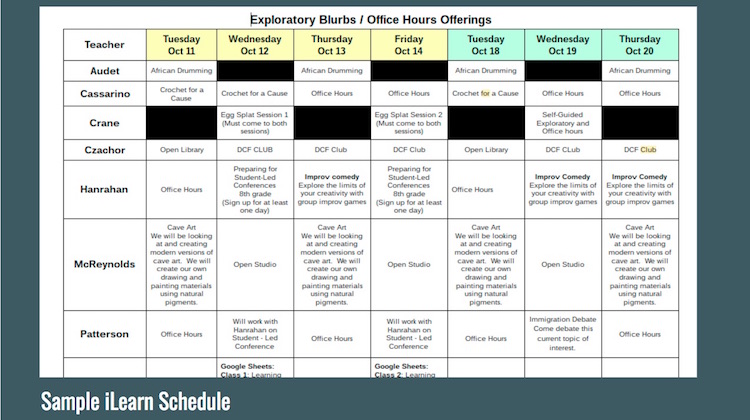
I print out the menu Monday morning and make eight copies. I hand it to the students in my advisory. They review it. They circle their first choice on each day that that they have available and they’ll bring it to me and we’ll sit down and look at their choices.
The student will have all that information and they will come up to me and say, “Mr. Crane, this Monday I know that Math teacher is offering doodle and I’d like to participate in that.” We talk about it and then I enter their name. At the same time, since this is a Google Doc, shared between all 13 advisers, you see things filling up.
As a team of educators, we made an agreement that there would be a 20-person cap on every iLearn.
If I’m offering “Ping-Pong Spins”, it doesn’t work to have 55 students on the table trying to learn how to spin a ping pong ball. We can’t have that.
It is up to you as the mentor and adviser to say, “Hey, you signed up for three exploratories and I know you need to work, I know you have a project coming.” And if you have a good relationship with the students in your advisory, that student is not going to say no. In my experience, all eight of my advisees are making excellent choices for themselves. They’re splitting up office hours and exploratories where they think they need it. I’ve been really, really impressed by that this year.
Rotating 115 kids every two weeks is challenging
Brian Crane: Some students say, “Hey, I don’t think I’m going to office hours, I think I’m going to go to open library today”, and then show up at office hours anyway. We’ve had to work through being better attendance-takers, making sure kids are where they’re supposed to go.
We do allow them to change, though.
Let’s say a student signed up for an exploratory, and then the next week they find that they’re way behind or they were sick, and they want to switch into my office hour. We just talk to the adviser. We try to keep the communication up. That’s happened in my team many, many times. And honestly it’s been very powerful.
Does it work for everyone?
Erica Zimmer: One thing is that the struggle has always been on special education services. How do we ensure that it’s fair for those students that have to have services? We have less than five students who have services Tuesday through Friday. Everybody is together on Mondays. There are no special education services on Monday because we believe that everyone should be together in teacher advisory.
The real challenge in our conversation that we have had is that if we have a student who on Tuesdays and Thursdays, has services, they might not be able to make both sessions of a single thing. So we’ve had to be really flexible because what we all agree is that we want it to be accessible for everybody. And fair.
This is, honestly, the best that we have been able to come up with. In past years, our special education students always missed electives. And we were like, “This isn’t fair, it’s not right.” This is the best way we found to make it accountable.
Brian Crane: I have a TA member who receives a lot of services. And I’ve worked with the special educator to try to at least get that student into one of the exploratories each time so they’re not missing out.
Staff and community members help provide instruction in exploratories
Erica Zimmer: As a tech innovationist, I can offer iLearn exploratories. I’ve just been doing things with what I have in my makerspace right now like 3D printing, and the kids love it.
All the exploratory teachers are core teachers or specialists–
Melissa Theis (school guidance counselor): And people like me.
Brian Crane: If anybody’s available and they have something to share, then we’ve encouraged them.
Melissa Theis: Our behavioral interventionist is starting an exploratory this coming week. She’s a dancer so she’s going to lead a choreography class. That was born of a student who’s really struggling right now and who’s really into dance and choreography.
I said, “Well, wouldn’t it be so cool if you could become a leader in a dance iLearn?”
So, I’m going to cover the interventionist’s behavior duties for that time so she can offer that class.
Once again, it’s a really nice way for students to bond with adults in the building. That comes back to some of our core beliefs that we want students to make connections with adults and to see that we have interests and passions outside of ourselves in this area.
Brian Crane: We have guest speakers coming in the language FSC show.
Erica Zimmer: And a financial planner.
There must be a way for students to teach iLearn exploratories
Brian Crane: One of the big deals we’re having right now is we have students who want to give iLearns. We have the “Balloon Man” who wants to do balloon-building. So right now we’re in the process of creating a structure around that so it’s not a free-for-all and it’s valuable for everybody. But I’m pretty sure we’re going to make that happen.
Erica Zimmer: That’s our desire: to eventually give this over to students. Right now, we’re not allowing service choice 100 percent because we’re directing what we offer. That’s our final goal, is to really listen to students about what they want and offer what they want, not what we think we have to offer.
Melissa Theis: I think you came up with a name that it’ll be: iTeach.
Erica Zimmer: iTeach. Right.
What do students think of iLearn?
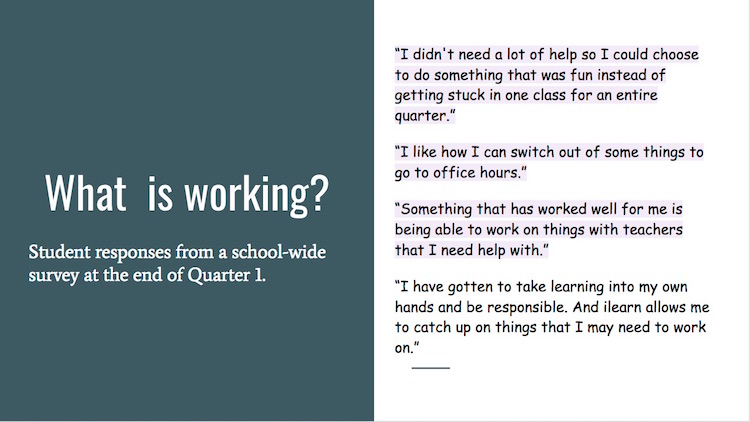
Melissa Theis: We did a little questionnaire with the students to kind of gauge how do they feel this is going. These are some of the responses that they’ve said: that they thought it was working. A lot of students, they like not having to be stuck in one class for an entire time. Some of the responses were that being able to do the office hours seem to be really beneficial for them.
Brian Crane: Obviously, nothing is perfect.
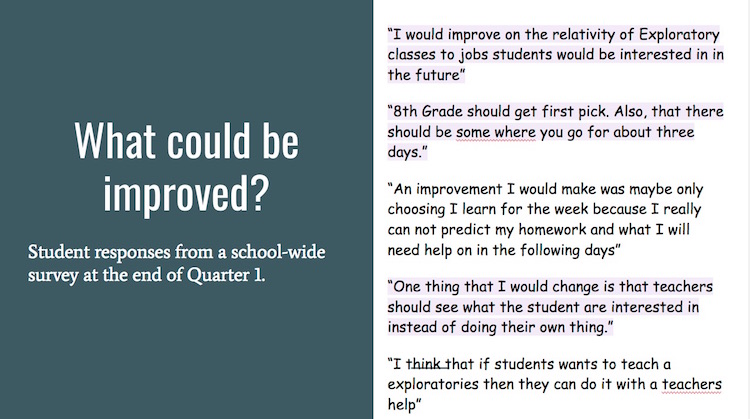
One of the biggest things is how you make it fair for everybody. Some 8th graders think 8th graders should pick first. I mean, that makes sense sometimes but… I like to, say, 8th graders pick first one week; 7th graders pick first the next week. Every adviser does it a little bit differently, but that has been a challenge.
Brian Crane: “I make thoughtful choices about whether to sign up for office hours or exploratories based on my academic needs”. We have 58 students strongly agreeing with that and another 48 students saying they agreed.
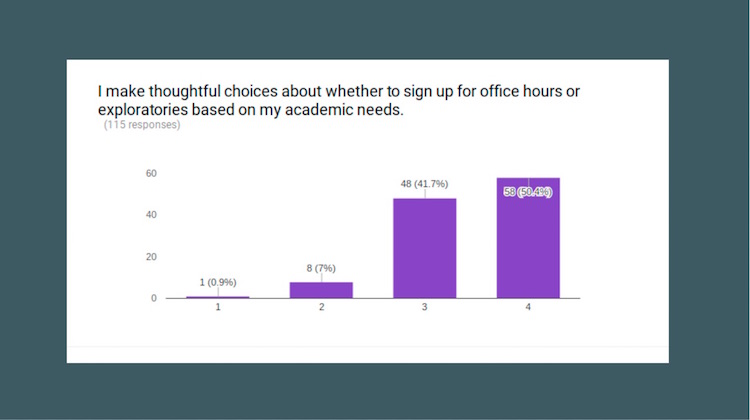
I think that’s excellent. I gave this survey out at the beginning of one of my sessions. I said, “Please be honest, be fair. Be fair but be honest.” And I think they have.
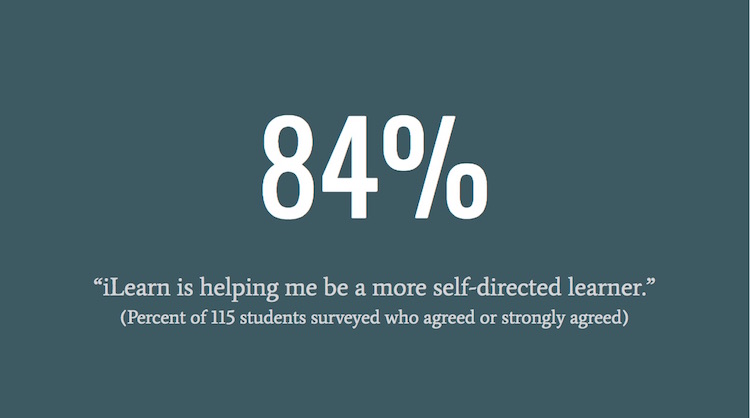
So, there’s been a lot of change this year but I like to think of the iLearn block as a middle school, this is one of our shining lights. This is one of our things that we can think of about this year 2016-2017, while that was a hard year, we had a lot of challenges, but the iLearn is really a positive thing, an innovative thing – something new that we’ve created that our students love.
Overall, adding more student choice into the schedule seems to have gone over pretty well.
Erica Zimmer: We had a lot of change, and there’s a whole lot of anxiety around all this change, but iLearn seems to be the constant that people are enjoying and liking, and it’s the one thing that freely hasn’t had a whole lot of complaints about teachers and students.
Melissa Theis: I’ve only heard positive from parents. That’s uniquely different than anything in our school. But we have heard overwhelmingly positive about iLearn from students, from parents, and another team. Everyone agrees that this is something we enjoy doing and want to keep and works well.
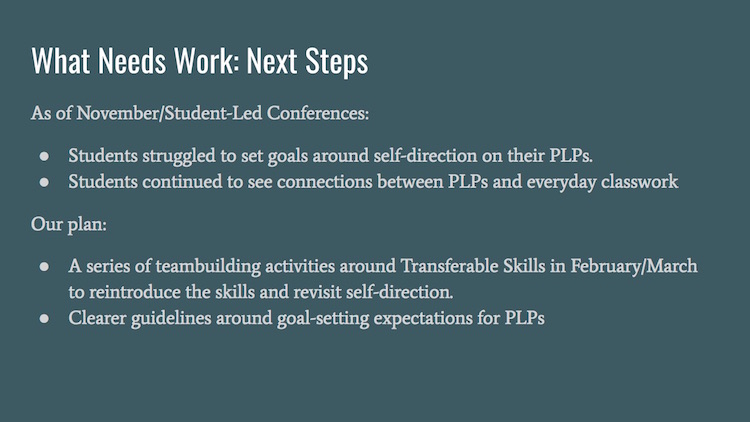
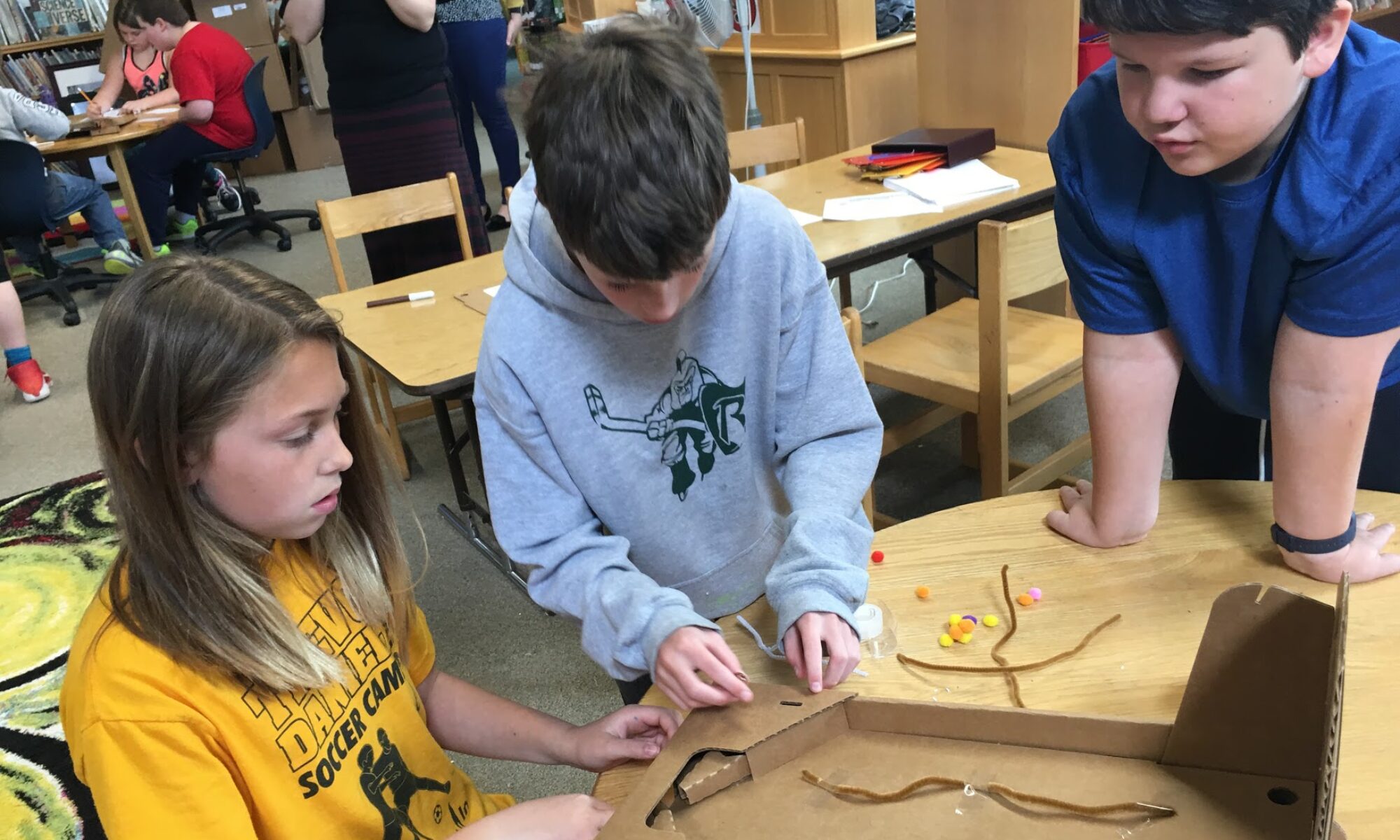

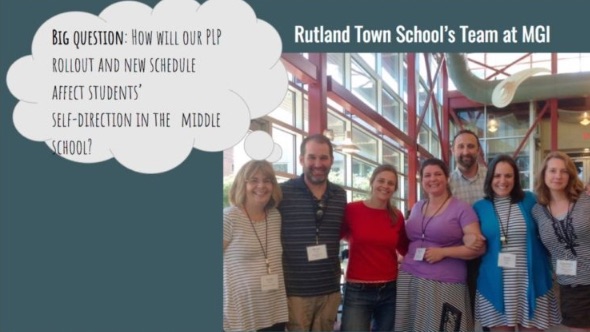
This is such a detailed article about Scheduling and student choice. I hope it will help schools and students both. I wish to share my experience. Our team using DeskFlex’s School Scheduling Software for a long time. it’s an amazing software system. the best thing it’s provides you a multiuser dashboard and you can schedule your school, classes, exams, according to student choice.